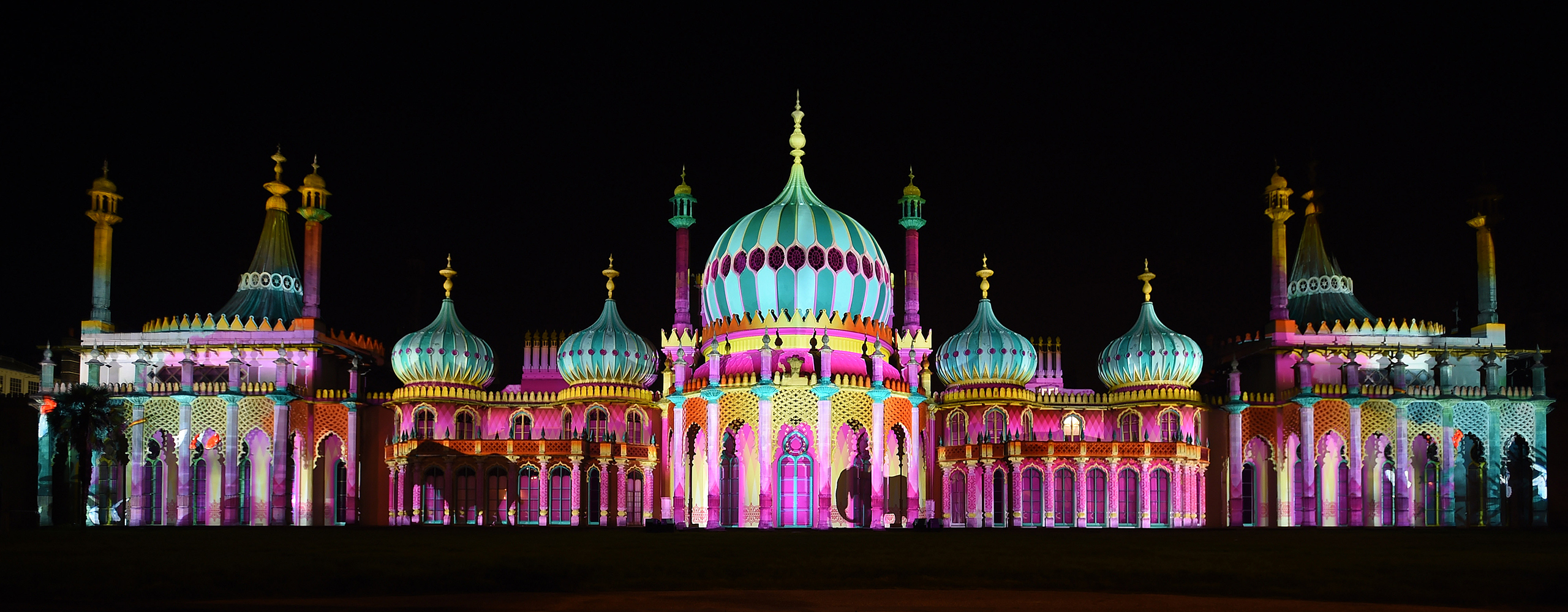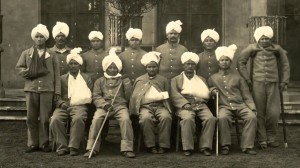Home, hope, fear, sacrifice… These are the themes at the heart of Dr Blighty, Nutkhut’s site-specific commission which, for the final week of the Brighton Festival, masterfully commandeered both the exterior of the gloriously oriental folly that is the Brighton Pavilion and its surrounding gardens.
The show is inspired by the extraordinary First World War story that, from 1914 to 1916, saw the Pavilion turned into a 722-bed hospital for soldiers of the Empire as ‘the fashionable promenades of Brighton became the footpaths to recovery for thousands of soldiers from the Indian sub-continent’. Letters home written by the soldiers stationed here are the starting point for the piece.
By day, we can freely wander through Pavilion Gardens, encountering a number of smaller pavilions hosting installation works. The Bedhead Pavilion looks like a bandstand, or a large birdcage, its open sides made from the sort of metal bedsteads that we presume were used in the Pavilion when it was home to thousands of men far from home. Here, we see postcards on strings fluttering in the wind. On the front of the cards, blurry black and white photographs; on the back, messages from present-day visitors sent back into the past. ‘We are so grateful for what you have done for us’ says one, in a delicate script. ‘I am so sorry you were hurt’ says another in a more childish hand.
Over in the Red and Gold Pavilion, a single bed, empty but made up and ready for its occupant. On the bed, a clipboard. Name: Rav Sim. Injury: a bullet to the hip. He’s one of the lucky ones – operated on, recuperating. He might have a bit of a limp, but he has got off lightly compared to some. Coming from the walls are a constant murmuring – the ‘surreal morphine-fuelled dreams of the wounded soldier’.
The White Pavilion is far more disturbing. Buckets of sand. (For what? To mop up the blood and the gore?) Rough hessian sacks dangling from butcher’s hooks. There are speakers inside the sacks, and you have to stay still and close to hear the war-torn sounds and snippets of stories that come through. ‘Tell my brother, for God’s sake don’t enlist’ says one voice, almost drowned out by the sounds of shells exploding.
Outside in the gardens, fragmented stories are conveyed through the medium of vintage brass gramophone horn speakers and gourds. Standing next to one, I hear of the smell of iodine and the burn of sulphur on the skin. In another, stories of arduous journeys from India to Brighton.
At twilight, a team of people of Asian heritage, dressed in period clothing, move across the large lawn to the front of the Pavilion, placing an armada of little diyas – tiny clay bowls, each containing a jewel-coloured nightlight – on the grass. These beautiful diyas have been made at a number of community and schools workshops led by Nutkhut. The quiet action is a lovely moment, and people watch quietly and respectfully (for the most part). The show has also embraced a number of other events including community choirs performing at the ‘bandstand’; two special concerts at the Brighton Dome; and a special commemoration service that included a wreath-laying and dedication of a blue plaque.
As night falls, the culmination of the event – and the part of the Dr Blighty that has got the whole of Brighton talking (and far further afield, courtesy of social media) – a 15-minute video mapping onto the back of the Brighton Pavilion, with accompanying sound composition. This can be seen and heard properly from inside the gardens, and seen (more-or-less) from outside the gardens in the street – or even, as I discovered on the opening night (Tuesday 24th), from across the road and down a side street, outside the Marlborough Theatre. This first casual viewing is enough to show me that what we have here is not the usual sort of video mapping, which is often little more than projection onto a building as if it were a screen. What I can see – even from afar, without my full attention – is that every little architectural detail of the Pavilion, its columns and domes and archways and minarets, is being thought about and truly mapped, a great merging of 2D and 3D.
On the return trip the next night, I watch the video installation properly from within the gardens. It starts with a melodic and melancholic Indian song sung by a male vocalist. The Pavilion is a moody construct of black shadows and old gold lights. Rich jewel colours erupt – emerald green, turquoise, ruby red – and the sound morphs to the babble of children’s voices and the clopping of horses’ hooves. As flutes sound, a magnificent row of shadow-elephants appear, moving from right to left across the whole width of the building. Rainbow-coloured butterflies flutter by, and the Pavilion is now a riot of candy colours – shocking pinks, brilliant blues, sherbet yellows, luscious lilacs. The mapping at this point is at its superb best – curves and lines and edges picked out with delicate precision. In the medley of sounds, a female voice pushes through into our consciousness: ‘Let this be my parting word…’ Rich lotus blooms erupt all over the building; the soundtrack becomes more mulched, more ominous, and we see images of Indian soldiers marching with flags, moving across the building. We hear the sounds of artillery, the boom of bombs, and the Pavilion is lit up in electric flashes. Then it is red, all red…
The music, composed by Shri Shrivam, holds the balance nicely between traditional Indian song and contemporary composition. Sound designer Ed Carter has worked it all together nicely. Video and animation work by Novak, lighting design by Phil Supple, and projection by QED, prove to be formidable team.
Apart from the beautiful spectacle that is this finale, it is also a very lovely pulling together of ideas and images that are explored collectively throughout the work, in all of the installations.
Soundscape artist Thor McIntyre has done a sterling job with an engaging sound installation delivered through speakers concealed in all sorts of clever ways around the gardens. And the whole thing was envisioned and put into practice by Nutkhut’s artistic director Ajay Chabra and his partner in Nutkhut, Simmy Gupta, working throughout the whole process with designer Tom Piper.
Although the term ’site specific’ is thrown around with gay abandon these days, it is unusual to see a piece of work that is genuinely specific to just one site. This is an example – Dr Blighty is about, and of, Brighton Pavilion, using a full tool-box of physical, visual and verbal storytelling to bring the site alive. It has proved to be an enormous success, news spreading throughout the city and beyond as the week progressed, with this part of Brighton brought to a standstill at the weekend as crowds poured in to see the projections – and when the site was declared full, people were standing in roads, on top of bus shelters, and up trees in an attempt to see the work. Beyond the live event, postings on social media have reached thousands more people.
This is a populist performance work in the best sense of the word. It has been warmly embraced by the people of Brighton who have taken Dr Blighty into their hearts. A fantastic example of the success of outdoor arts that is free to audience, and an amazing end to the Brighton Festival 2016.


